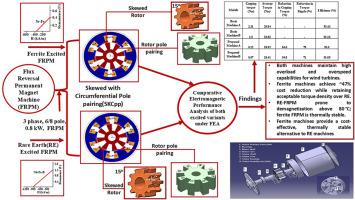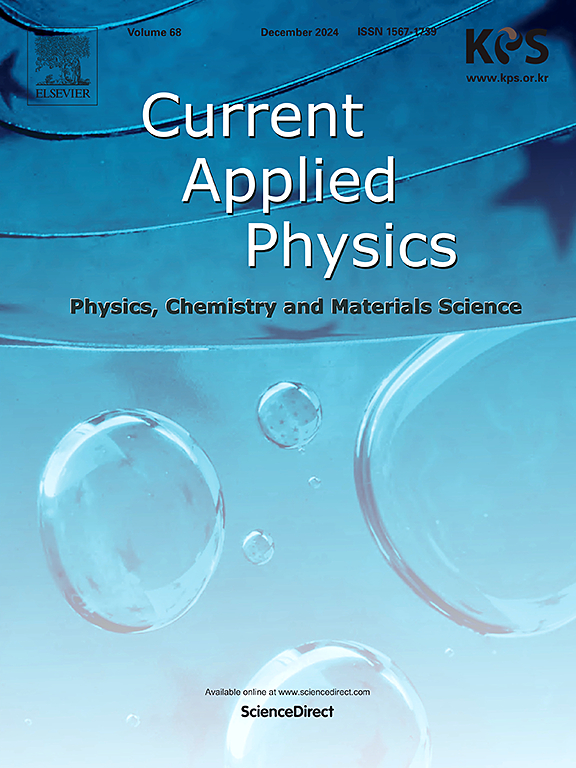微风能稀土与非稀土激励磁通反转机性能评价
IF 3.1
4区 物理与天体物理
Q3 MATERIALS SCIENCE, MULTIDISCIPLINARY
引用次数: 0
摘要
磁通反转电机由于其独特的双凸极拓扑结构,与其他类型的定子有源永磁电机相比,其齿槽转矩相对较高。本研究提出了一种新型偏转转子极对混合方法(SKCpp),并利用二维有限元分析(FEA)对其进行了分析,比较了其在稀土(RE-FRM)和铁氧体(NRE)两种不同励磁拓扑下的性能。建立了三相6/8极FRM模型,并与具有相似性能要求的RE激励FRM(机器A)和NRE激励FRM(机器B)进行了电磁性能比较。这些不同的励磁机器根据其发电性能进行评估,通过二维有限元分析展示了卓越的过载和速度能力。A机的效率略高于B机,但齿槽转矩和转矩脉动比B机高40%以上。结果发现,机器B的扭矩密度仅为机器A的54%,但由于机器重量是机器A的1.8倍,采用这种结构可以节省47%的成本。此外,可在高达150°C的温度下进行退磁风险分析。在较高的温度下,由于温度敏感性,机器A容易出现更深的退磁风险,这会降低功率因数,从而限制发电机的性能。与机器A和机器B不同,它们具有最小的退磁风险,发生在室温下记录。综上所述,在中速风力发电机应用中,NRE励磁提议机B是替代RE励磁提议机A的最佳选择。本文章由计算机程序翻译,如有差异,请以英文原文为准。

Performance evaluation of flux reversal machines with rare-earth and non-rare earth excitations for micro wind energy
Cogging torque in flux-reversal machines (FRM) is relatively high compared with other types of stator active PM machines, due to their unique double salient topology. This research develops a hybrid novel skew with rotor pole pairing (SKCpp) method and analyses it using 2D finite element analysis (FEA), comparing its performance with two distinct excitation topologies, i.e., rare earth (RE-FRM) and ferrite (NRE) flux reversal machines (FRMs). The 3-phase, 6/8 pole FRM is modeled, and electromagnetic performances are compared with RE excited FRM (Machine A) and NRE excited FRM (Machine B), which have similar performance requirements for wind generator applications. These various excited machines are evaluated based on their power generation performance, demonstrating exceptional overload and speed capabilities through 2D FEA. The efficiency of Machine A is somewhat higher than that of Machine B, but cogging torque and torque ripples are at least 40 % higher than those of the former. It is found that the torque density of Machine B is only 54 % of that of Machine A, but by employing this structure, the cost saving is achieved by 47 %, since the machine is 1.8 times heavier. Further, the demagnetization risk analysis is performed up to 150 °C. At higher temperatures, Machine A is prone to deeper demagnetization risk, due to temperature susceptibility, which degrades the power factor and thereby limits the performance of the generator. Unlike Machine A and Machine B, which possess the minimum demagnetization risk, the occurrence is recorded below room temperature. Overall summary, it is found that the NRE excited proposed Machine B is the best alternative to the RE excited proposed Machine A for medium speed wind turbine generator applications.
求助全文
通过发布文献求助,成功后即可免费获取论文全文。
去求助
来源期刊

Current Applied Physics
物理-材料科学:综合
CiteScore
4.80
自引率
0.00%
发文量
213
审稿时长
33 days
期刊介绍:
Current Applied Physics (Curr. Appl. Phys.) is a monthly published international journal covering all the fields of applied science investigating the physics of the advanced materials for future applications.
Other areas covered: Experimental and theoretical aspects of advanced materials and devices dealing with synthesis or structural chemistry, physical and electronic properties, photonics, engineering applications, and uniquely pertinent measurement or analytical techniques.
Current Applied Physics, published since 2001, covers physics, chemistry and materials science, including bio-materials, with their engineering aspects. It is a truly interdisciplinary journal opening a forum for scientists of all related fields, a unique point of the journal discriminating it from other worldwide and/or Pacific Rim applied physics journals.
Regular research papers, letters and review articles with contents meeting the scope of the journal will be considered for publication after peer review.
The Journal is owned by the Korean Physical Society.
 求助内容:
求助内容: 应助结果提醒方式:
应助结果提醒方式:


